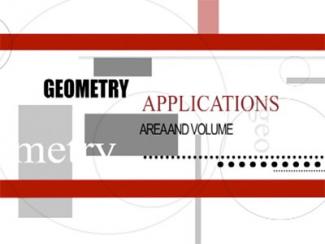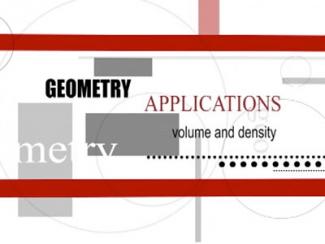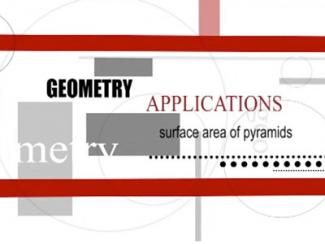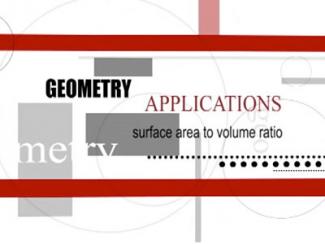
Illustrative Math Alignment: Grade 6 Unit 1
Reasoning to Find Area
Lesson 16: Distinguishing Between Surface Area and Volume
Use the following Media4Math resources with this Illustrative Math lesson.
| Thumbnail Image | Title | Body | Curriculum Nodes |
|---|---|---|---|

|
Video Transcript: Geometry Applications: Area and Volume |
Video Transcript: Geometry Applications: Area and Volume
This is the transcript for the video of same title. Video contents: In this program we look at applications of area and volume. We do this in the context of three real-world applications. In the first, we look at the sinking of the Titanic in the context of volume and density. In the second application we look at the glass pyramid at the Louvre Museum and calculate its surface area. In the third application we look at the Citibank Tower in New York City to study the ratio of surface area to volume to learn about heat loss in tall buildings. |
Applications of Surface Area and Volume |

|
Video Transcript: Geometry Applications: Area and Volume |
Video Transcript: Geometry Applications: Area and Volume
This is the transcript for the video of same title. Video contents: In this program we look at applications of area and volume. We do this in the context of three real-world applications. In the first, we look at the sinking of the Titanic in the context of volume and density. In the second application we look at the glass pyramid at the Louvre Museum and calculate its surface area. In the third application we look at the Citibank Tower in New York City to study the ratio of surface area to volume to learn about heat loss in tall buildings. |
Applications of Surface Area and Volume |

|
Video Transcript: Geometry Applications: Area and Volume |
Video Transcript: Geometry Applications: Area and Volume
This is the transcript for the video of same title. Video contents: In this program we look at applications of area and volume. We do this in the context of three real-world applications. In the first, we look at the sinking of the Titanic in the context of volume and density. In the second application we look at the glass pyramid at the Louvre Museum and calculate its surface area. In the third application we look at the Citibank Tower in New York City to study the ratio of surface area to volume to learn about heat loss in tall buildings. |
Applications of Surface Area and Volume |

|
Video Transcript: Geometry Applications: Area and Volume |
Video Transcript: Geometry Applications: Area and Volume
This is the transcript for the video of same title. Video contents: In this program we look at applications of area and volume. We do this in the context of three real-world applications. In the first, we look at the sinking of the Titanic in the context of volume and density. In the second application we look at the glass pyramid at the Louvre Museum and calculate its surface area. In the third application we look at the Citibank Tower in New York City to study the ratio of surface area to volume to learn about heat loss in tall buildings. |
Applications of Surface Area and Volume |

|
Video Transcript: Geometry Applications: Area and Volume, Segment 1: Volume and Density. |
Video Transcript: Geometry Applications: Area and Volume, Segment 1: Volume and Density.
This is the transcript for the video of same title. Video contents: The sinking of the Titanic provides an opportunity to explore volume, density, and buoyancy. Students construct a mathematical model of the Titanic to determine why it sank and what could have been done to prevent it from sinking. |
Applications of Surface Area and Volume |

|
Video Transcript: Geometry Applications: Area and Volume, Segment 1: Volume and Density. |
Video Transcript: Geometry Applications: Area and Volume, Segment 1: Volume and Density.
This is the transcript for the video of same title. Video contents: The sinking of the Titanic provides an opportunity to explore volume, density, and buoyancy. Students construct a mathematical model of the Titanic to determine why it sank and what could have been done to prevent it from sinking. |
Applications of Surface Area and Volume |

|
Video Transcript: Geometry Applications: Area and Volume, Segment 1: Volume and Density. |
Video Transcript: Geometry Applications: Area and Volume, Segment 1: Volume and Density.
This is the transcript for the video of same title. Video contents: The sinking of the Titanic provides an opportunity to explore volume, density, and buoyancy. Students construct a mathematical model of the Titanic to determine why it sank and what could have been done to prevent it from sinking. |
Applications of Surface Area and Volume |

|
Video Transcript: Geometry Applications: Area and Volume, Segment 2: Surface Area. |
Video Transcript: Geometry Applications: Area and Volume, Segment 2: Surface Area.
This is the transcript for the video of same title. Video contents: The glass-paneled pyramid at the Louvre Museum in Paris is a tessellation of rhombus-shaped glass panels. Students create a model of the pyramid to calculate the number of panels used to cover the surface area of the pyramid. |
Applications of Surface Area and Volume |

|
Video Transcript: Geometry Applications: Area and Volume, Segment 2: Surface Area. |
Video Transcript: Geometry Applications: Area and Volume, Segment 2: Surface Area.
This is the transcript for the video of same title. Video contents: The glass-paneled pyramid at the Louvre Museum in Paris is a tessellation of rhombus-shaped glass panels. Students create a model of the pyramid to calculate the number of panels used to cover the surface area of the pyramid. |
Applications of Surface Area and Volume |

|
Video Transcript: Geometry Applications: Area and Volume, Segment 2: Surface Area. |
Video Transcript: Geometry Applications: Area and Volume, Segment 2: Surface Area.
This is the transcript for the video of same title. Video contents: The glass-paneled pyramid at the Louvre Museum in Paris is a tessellation of rhombus-shaped glass panels. Students create a model of the pyramid to calculate the number of panels used to cover the surface area of the pyramid. |
Applications of Surface Area and Volume |

|
Video Transcript: Geometry Applications: Area and Volume, Segment 2: Surface Area. |
Video Transcript: Geometry Applications: Area and Volume, Segment 2: Surface Area.
This is the transcript for the video of same title. Video contents: The glass-paneled pyramid at the Louvre Museum in Paris is a tessellation of rhombus-shaped glass panels. Students create a model of the pyramid to calculate the number of panels used to cover the surface area of the pyramid. |
Applications of Surface Area and Volume |

|
Video Transcript: Geometry Applications: Area and Volume, Segment 3: Ratio of Surface Area to Volume |
Video Transcript: Geometry Applications: Area and Volume, Segment 3: Ratio of Surface Area to Volume
This is the transcript for the video of same title. Video contents: The Citibank Tower in New York City presents some unique design challenges. In addition it has to cope with a problem that all tall structure have to deal with: heat loss. By managing the ratio of surface area to volume, a skyscraper can effective manage heat loss. |
Applications of Surface Area and Volume |

|
Video Transcript: Geometry Applications: Area and Volume, Segment 3: Ratio of Surface Area to Volume |
Video Transcript: Geometry Applications: Area and Volume, Segment 3: Ratio of Surface Area to Volume
This is the transcript for the video of same title. Video contents: The Citibank Tower in New York City presents some unique design challenges. In addition it has to cope with a problem that all tall structure have to deal with: heat loss. By managing the ratio of surface area to volume, a skyscraper can effective manage heat loss. |
Applications of Surface Area and Volume |

|
Video Transcript: Geometry Applications: Area and Volume, Segment 3: Ratio of Surface Area to Volume |
Video Transcript: Geometry Applications: Area and Volume, Segment 3: Ratio of Surface Area to Volume
This is the transcript for the video of same title. Video contents: The Citibank Tower in New York City presents some unique design challenges. In addition it has to cope with a problem that all tall structure have to deal with: heat loss. By managing the ratio of surface area to volume, a skyscraper can effective manage heat loss. |
Applications of Surface Area and Volume |

|
Video Transcript: Geometry Applications: Area and Volume, Segment 3: Ratio of Surface Area to Volume |
Video Transcript: Geometry Applications: Area and Volume, Segment 3: Ratio of Surface Area to Volume
This is the transcript for the video of same title. Video contents: The Citibank Tower in New York City presents some unique design challenges. In addition it has to cope with a problem that all tall structure have to deal with: heat loss. By managing the ratio of surface area to volume, a skyscraper can effective manage heat loss. |
Applications of Surface Area and Volume |

|
VIDEO: Geometry Applications: Area and Volume |
VIDEO: Geometry Applications: Area and Volume
TopicArea and Volume |
Applications of Surface Area and Volume, Surface Area and Volume |

|
VIDEO: Geometry Applications: Area and Volume |
VIDEO: Geometry Applications: Area and Volume
TopicArea and Volume |
Applications of Surface Area and Volume, Surface Area and Volume |

|
VIDEO: Geometry Applications: Area and Volume |
VIDEO: Geometry Applications: Area and Volume
TopicArea and Volume |
Applications of Surface Area and Volume, Surface Area and Volume |

|
VIDEO: Geometry Applications: Area and Volume |
VIDEO: Geometry Applications: Area and Volume
TopicArea and Volume |
Applications of Surface Area and Volume, Surface Area and Volume |

|
VIDEO: Geometry Applications: Area and Volume |
VIDEO: Geometry Applications: Area and Volume
TopicArea and Volume |
Applications of Surface Area and Volume, Surface Area and Volume |

|
VIDEO: Geometry Applications: Area and Volume, 1 |
VIDEO: Geometry Applications: Area and Volume, 1
TopicArea and Volume DescriptionThis segment explores the concept of density, using the Titanic to demonstrate buoyancy and the relationship between mass and volume. It introduces direct variation, rational functions, and how these principles apply to ship design for optimal floating capacity. |
Applications of Surface Area and Volume, Surface Area and Volume |

|
VIDEO: Geometry Applications: Area and Volume, 1 |
VIDEO: Geometry Applications: Area and Volume, 1
TopicArea and Volume DescriptionThis segment explores the concept of density, using the Titanic to demonstrate buoyancy and the relationship between mass and volume. It introduces direct variation, rational functions, and how these principles apply to ship design for optimal floating capacity. |
Applications of Surface Area and Volume, Surface Area and Volume |

|
VIDEO: Geometry Applications: Area and Volume, 1 |
VIDEO: Geometry Applications: Area and Volume, 1
TopicArea and Volume DescriptionThis segment explores the concept of density, using the Titanic to demonstrate buoyancy and the relationship between mass and volume. It introduces direct variation, rational functions, and how these principles apply to ship design for optimal floating capacity. |
Applications of Surface Area and Volume, Surface Area and Volume |

|
VIDEO: Geometry Applications: Area and Volume, 1 |
VIDEO: Geometry Applications: Area and Volume, 1
TopicArea and Volume DescriptionThis segment explores the concept of density, using the Titanic to demonstrate buoyancy and the relationship between mass and volume. It introduces direct variation, rational functions, and how these principles apply to ship design for optimal floating capacity. |
Applications of Surface Area and Volume, Surface Area and Volume |

|
VIDEO: Geometry Applications: Area and Volume, 1 |
VIDEO: Geometry Applications: Area and Volume, 1
TopicArea and Volume DescriptionThis segment explores the concept of density, using the Titanic to demonstrate buoyancy and the relationship between mass and volume. It introduces direct variation, rational functions, and how these principles apply to ship design for optimal floating capacity. |
Applications of Surface Area and Volume, Surface Area and Volume |

|
VIDEO: Geometry Applications: Area and Volume, 1 |
VIDEO: Geometry Applications: Area and Volume, 1
TopicArea and Volume DescriptionThis segment explores the concept of density, using the Titanic to demonstrate buoyancy and the relationship between mass and volume. It introduces direct variation, rational functions, and how these principles apply to ship design for optimal floating capacity. |
Applications of Surface Area and Volume, Surface Area and Volume |

|
VIDEO: Geometry Applications: Area and Volume, 1 |
VIDEO: Geometry Applications: Area and Volume, 1
TopicArea and Volume DescriptionThis segment explores the concept of density, using the Titanic to demonstrate buoyancy and the relationship between mass and volume. It introduces direct variation, rational functions, and how these principles apply to ship design for optimal floating capacity. |
Applications of Surface Area and Volume, Surface Area and Volume |

|
VIDEO: Geometry Applications: Area and Volume, 1 |
VIDEO: Geometry Applications: Area and Volume, 1
TopicArea and Volume DescriptionThis segment explores the concept of density, using the Titanic to demonstrate buoyancy and the relationship between mass and volume. It introduces direct variation, rational functions, and how these principles apply to ship design for optimal floating capacity. |
Applications of Surface Area and Volume, Surface Area and Volume |

|
VIDEO: Geometry Applications: Area and Volume, 1 |
VIDEO: Geometry Applications: Area and Volume, 1
TopicArea and Volume DescriptionThis segment explores the concept of density, using the Titanic to demonstrate buoyancy and the relationship between mass and volume. It introduces direct variation, rational functions, and how these principles apply to ship design for optimal floating capacity. |
Applications of Surface Area and Volume, Surface Area and Volume |

|
VIDEO: Geometry Applications: Area and Volume, 1 |
VIDEO: Geometry Applications: Area and Volume, 1
TopicArea and Volume DescriptionThis segment explores the concept of density, using the Titanic to demonstrate buoyancy and the relationship between mass and volume. It introduces direct variation, rational functions, and how these principles apply to ship design for optimal floating capacity. |
Applications of Surface Area and Volume, Surface Area and Volume |

|
VIDEO: Geometry Applications: Area and Volume, 2 |
VIDEO: Geometry Applications: Area and Volume, 2
TopicArea and Volume DescriptionThis segment focuses on surface area, using the Louvre Pyramid to highlight geometric tessellations and triangular net calculations. It explains the surface area formula for pyramids and how these calculations are applied in architectural design and material efficiency. |
Applications of Surface Area and Volume, Surface Area and Volume |

|
VIDEO: Geometry Applications: Area and Volume, 2 |
VIDEO: Geometry Applications: Area and Volume, 2
TopicArea and Volume DescriptionThis segment focuses on surface area, using the Louvre Pyramid to highlight geometric tessellations and triangular net calculations. It explains the surface area formula for pyramids and how these calculations are applied in architectural design and material efficiency. |
Applications of Surface Area and Volume, Surface Area and Volume |

|
VIDEO: Geometry Applications: Area and Volume, 2 |
VIDEO: Geometry Applications: Area and Volume, 2
TopicArea and Volume DescriptionThis segment focuses on surface area, using the Louvre Pyramid to highlight geometric tessellations and triangular net calculations. It explains the surface area formula for pyramids and how these calculations are applied in architectural design and material efficiency. |
Applications of Surface Area and Volume, Surface Area and Volume |

|
VIDEO: Geometry Applications: Area and Volume, 2 |
VIDEO: Geometry Applications: Area and Volume, 2
TopicArea and Volume DescriptionThis segment focuses on surface area, using the Louvre Pyramid to highlight geometric tessellations and triangular net calculations. It explains the surface area formula for pyramids and how these calculations are applied in architectural design and material efficiency. |
Applications of Surface Area and Volume, Surface Area and Volume |

|
VIDEO: Geometry Applications: Area and Volume, 2 |
VIDEO: Geometry Applications: Area and Volume, 2
TopicArea and Volume DescriptionThis segment focuses on surface area, using the Louvre Pyramid to highlight geometric tessellations and triangular net calculations. It explains the surface area formula for pyramids and how these calculations are applied in architectural design and material efficiency. |
Applications of Surface Area and Volume, Surface Area and Volume |

|
VIDEO: Geometry Applications: Area and Volume, 2 |
VIDEO: Geometry Applications: Area and Volume, 2
TopicArea and Volume DescriptionThis segment focuses on surface area, using the Louvre Pyramid to highlight geometric tessellations and triangular net calculations. It explains the surface area formula for pyramids and how these calculations are applied in architectural design and material efficiency. |
Applications of Surface Area and Volume, Surface Area and Volume |

|
VIDEO: Geometry Applications: Area and Volume, 2 |
VIDEO: Geometry Applications: Area and Volume, 2
TopicArea and Volume DescriptionThis segment focuses on surface area, using the Louvre Pyramid to highlight geometric tessellations and triangular net calculations. It explains the surface area formula for pyramids and how these calculations are applied in architectural design and material efficiency. |
Applications of Surface Area and Volume, Surface Area and Volume |

|
VIDEO: Geometry Applications: Area and Volume, 2 |
VIDEO: Geometry Applications: Area and Volume, 2
TopicArea and Volume DescriptionThis segment focuses on surface area, using the Louvre Pyramid to highlight geometric tessellations and triangular net calculations. It explains the surface area formula for pyramids and how these calculations are applied in architectural design and material efficiency. |
Applications of Surface Area and Volume, Surface Area and Volume |

|
VIDEO: Geometry Applications: Area and Volume, 2 |
VIDEO: Geometry Applications: Area and Volume, 2
TopicArea and Volume DescriptionThis segment focuses on surface area, using the Louvre Pyramid to highlight geometric tessellations and triangular net calculations. It explains the surface area formula for pyramids and how these calculations are applied in architectural design and material efficiency. |
Applications of Surface Area and Volume, Surface Area and Volume |

|
VIDEO: Geometry Applications: Area and Volume, 2 |
VIDEO: Geometry Applications: Area and Volume, 2
TopicArea and Volume DescriptionThis segment focuses on surface area, using the Louvre Pyramid to highlight geometric tessellations and triangular net calculations. It explains the surface area formula for pyramids and how these calculations are applied in architectural design and material efficiency. |
Applications of Surface Area and Volume, Surface Area and Volume |

|
VIDEO: Geometry Applications: Area and Volume, 3 |
VIDEO: Geometry Applications: Area and Volume, 3
TopicArea and Volume DescriptionThis segment explores the surface area-to-volume ratio using the Citigroup Building as an example. It discusses how this ratio impacts energy efficiency in buildings and compares it to natural examples like polar bears and snakes for context. |
Applications of Surface Area and Volume, Surface Area and Volume |

|
VIDEO: Geometry Applications: Area and Volume, 3 |
VIDEO: Geometry Applications: Area and Volume, 3
TopicArea and Volume DescriptionThis segment explores the surface area-to-volume ratio using the Citigroup Building as an example. It discusses how this ratio impacts energy efficiency in buildings and compares it to natural examples like polar bears and snakes for context. |
Applications of Surface Area and Volume, Surface Area and Volume |

|
VIDEO: Geometry Applications: Area and Volume, 3 |
VIDEO: Geometry Applications: Area and Volume, 3
TopicArea and Volume DescriptionThis segment explores the surface area-to-volume ratio using the Citigroup Building as an example. It discusses how this ratio impacts energy efficiency in buildings and compares it to natural examples like polar bears and snakes for context. |
Applications of Surface Area and Volume, Surface Area and Volume |

|
VIDEO: Geometry Applications: Area and Volume, 3 |
VIDEO: Geometry Applications: Area and Volume, 3
TopicArea and Volume DescriptionThis segment explores the surface area-to-volume ratio using the Citigroup Building as an example. It discusses how this ratio impacts energy efficiency in buildings and compares it to natural examples like polar bears and snakes for context. |
Applications of Surface Area and Volume, Surface Area and Volume |

|
VIDEO: Geometry Applications: Area and Volume, 3 |
VIDEO: Geometry Applications: Area and Volume, 3
TopicArea and Volume DescriptionThis segment explores the surface area-to-volume ratio using the Citigroup Building as an example. It discusses how this ratio impacts energy efficiency in buildings and compares it to natural examples like polar bears and snakes for context. |
Applications of Surface Area and Volume, Surface Area and Volume |

|
VIDEO: Geometry Applications: Area and Volume, 3 |
VIDEO: Geometry Applications: Area and Volume, 3
TopicArea and Volume DescriptionThis segment explores the surface area-to-volume ratio using the Citigroup Building as an example. It discusses how this ratio impacts energy efficiency in buildings and compares it to natural examples like polar bears and snakes for context. |
Applications of Surface Area and Volume, Surface Area and Volume |

|
VIDEO: Geometry Applications: Area and Volume, 3 |
VIDEO: Geometry Applications: Area and Volume, 3
TopicArea and Volume DescriptionThis segment explores the surface area-to-volume ratio using the Citigroup Building as an example. It discusses how this ratio impacts energy efficiency in buildings and compares it to natural examples like polar bears and snakes for context. |
Applications of Surface Area and Volume, Surface Area and Volume |

|
VIDEO: Geometry Applications: Area and Volume, 3 |
VIDEO: Geometry Applications: Area and Volume, 3
TopicArea and Volume DescriptionThis segment explores the surface area-to-volume ratio using the Citigroup Building as an example. It discusses how this ratio impacts energy efficiency in buildings and compares it to natural examples like polar bears and snakes for context. |
Applications of Surface Area and Volume, Surface Area and Volume |